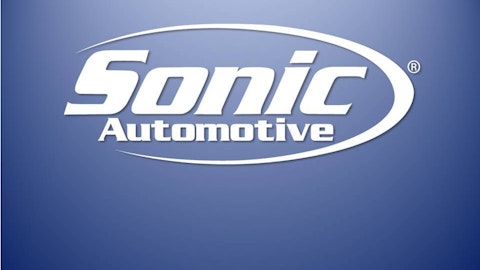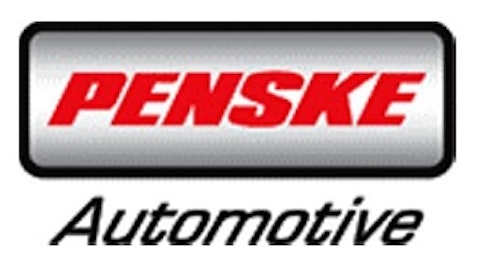Mean reversion is a powerful force that no one should ignore. The average length of ownership of new vehicles has jumped from 8.4 years in 1995 to 10.8 years in 2012. Add cheap financing to the equation and the outlook for U.S. auto sales looks bright.

Why the U.S. auto market is on the uptrend
Firstly, there is serious pent-up demand from consumers. One key indicator is the average ownership period of a car. According to the results of a 2012 study by Experian Automotive, Americans are staying with their existing cars for an average of 10.8 years in 2012. This not only represents a 9% increase in average vehicle age from 9.8 years in 2008, but also a quantum leap from 8.4 years, the average age of cars on the road in 1995.
Secondly, for big-ticket items like cars and homes, consumer confidence alone is insufficient to drive demand without cheap financing. According to Equifax Inc. (NYSE:EFX)’s National Consumer Credit Trends Report, new credit for auto loans amounting to $69.6 billion was originated in the first two months of this year, representing a 73% increase over the new auto credit of $40.2 billion for the same time period in 2009. This is an indication of both the availability of cheap credit and rising approval rates for auto customers.
Repair and maintenance to the rescue, if things do not work out
If the rosy picture for the U.S. auto market does not materialize, Sonic Automotive Inc (NYSE:SAH) still has its dependable repair and maintenance (or fixed operations) business to fall back on. When your car malfunctions, you can hold back maintenance for a while, but not indefinitely. The non-cyclicality of the repair and maintenance business explains why Sonic Automotive Inc (NYSE:SAH) has achieved profitability in nine out of the last 10 years in the past decade. It derives about 14% and 46% of its revenue and gross profit, respectively, from this business segment.
There are also two factors contributing to the increase in demand for repair and maintenance. One of them is the longer warranty periods for new cars, which means that car owners are more likely to get their cars serviced at dealers like Sonic Automotive Inc (NYSE:SAH). Another factor is the increasing complexity of cars with the advancement in technology. Your friendly neighborhood mechanic now lacks the relevant technical skills and equipment to service a lot of the new car models.
Strategy of owning more dealership properties makes sense
While dealership groups usually take out operating leases for their properties, Sonic Automotive Inc (NYSE:SAH) began buying some of its dealership properties since 2008 and now owns about a quarter of its dealership properties under its own name. It has plans to own about 44% of its dealership properties by 2017, according to its most recent presentation. Besides having increased flexibility with the utilization of the properties, Sonic Automotive also does not have to worry about rent hikes or forced vacation.
Peer comparison
Sonic Automotive’s peers include Group 1 Automotive, Inc. (NYSE:GPI) and Penske Automotive Group, Inc. (NYSE:PAG). Sonic Automotive is the most undervalued of its peers at 10 times forward P/E, despite boasting of the highest ROA at 5.9%.
Group 1 Automotive, Inc. (NYSE:GPI) is still very much a domestic play with 87% of its new-unit vehicle sales generated within the U.S. The U.K. and Brazil account for the remaining 9% and 4%of sales, respectively. Despite being the fourth-largest auto dealership group in the country, there is still ample room for growth for Group 1 Automotive, Inc. (NYSE:GPI).
In the U.S., the auto-dealership market is very fragmented with the top 10 dealership groups having less than 10% of market share. Management mentioned at its latest earnings conference call that they are observing more aging franchise owners considering exit options to their advantage.
Penske Automotive Group, Inc. (NYSE:PAG) is more geographically diversified than its peers, with 37% of sales generated outside the U.S. It sports the highest forward dividend yield of the three stocks with a 1.9% yield. The positive outlook for future dividends is supported by a stronger balance sheet and recent financial results.
Penske Automotive Group, Inc. (NYSE:PAG)’s de-leveraging efforts over the past few years have seen its debt-to-total-capital ratio halved from 4.0 times in 2009 to 2.0 times at the end of March of this year. Also, in the first quarter of fiscal 2013, it registered its highest earnings in its history, on the back of strong growth across each of its businesses and margin enhancement.
Going forward, Penske Automotive Group, Inc. (NYSE:PAG) strives to maintain its profitability through a minimum revenue growth target of 10% through same-store growth and acquisitions; and improved cost efficiencies by reducing selling, general & administrative expenses.
Conclusion
Among the three stocks, I prefer Sonic Automotive given its domestic focus, which exposes it to the uptrend in the U.S. auto cycle. In addition, I am positive on its strategy of owning more dealership properties to avoid future rental hikes or being forced to vacate when the lease is up for renewal. Investors are advised to consider Sonic Automotive, attractively valued at a PEG of 0.5.
Mark Lin has no position in any stocks mentioned. The Motley Fool has no position in any of the stocks mentioned. Mark is a member of The Motley Fool Blog Network — entries represent the personal opinion of the blogger and are not formally edited.
The article Mismatch Between Valuation and Profitability Makes This Stock a Buy originally appeared on Fool.com is written by Mark Lin.
Copyright © 1995 – 2013 The Motley Fool, LLC. All rights reserved. The Motley Fool has a disclosure policy.





